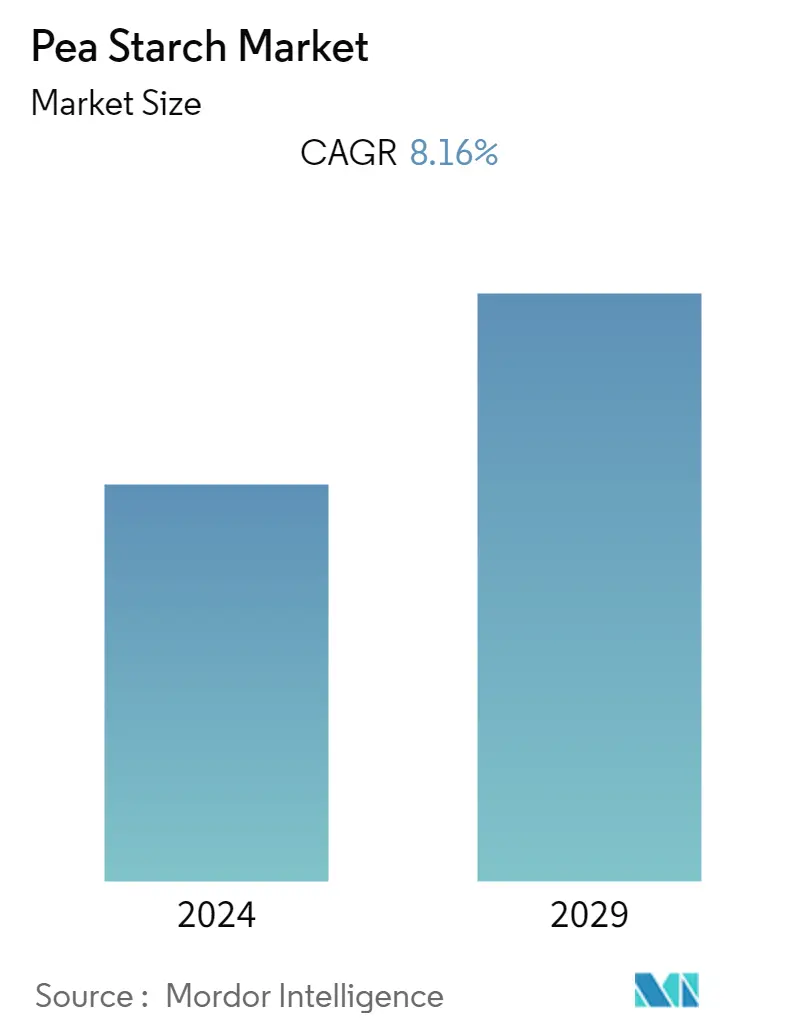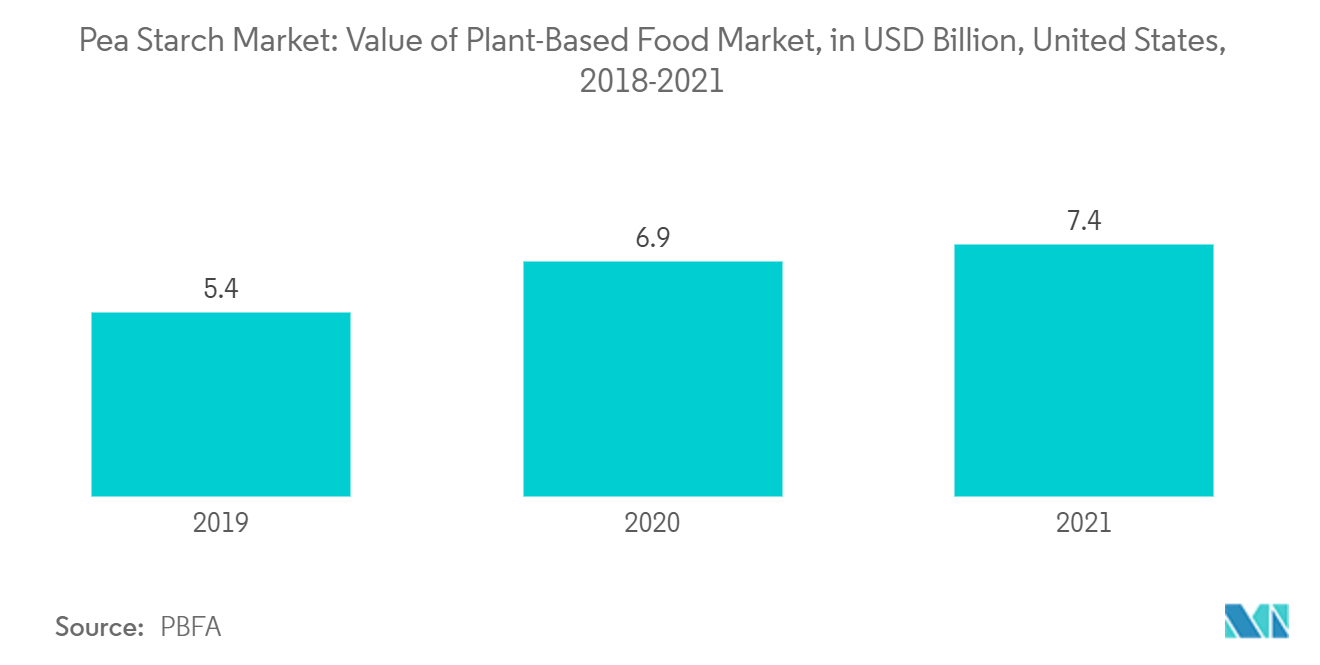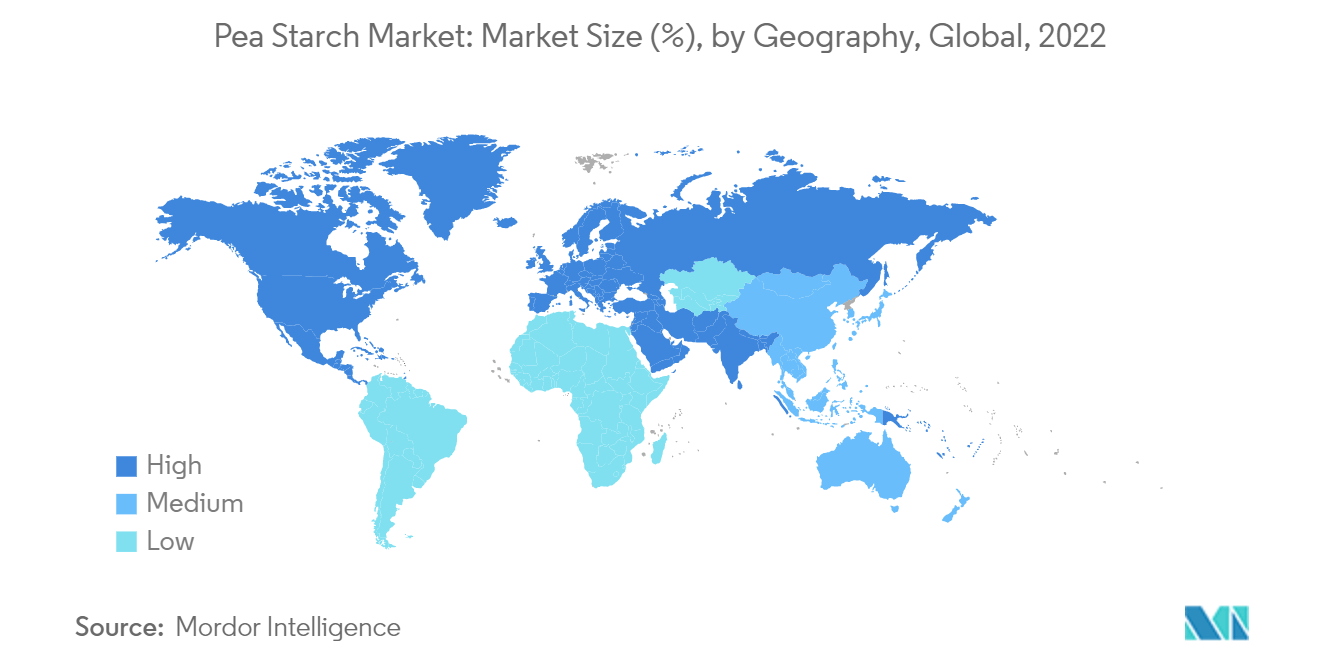Pea Starch Market Size

| Study Period | 2019 - 2029 |
| Base Year For Estimation | 2023 |
| CAGR | 8.16 % |
| Fastest Growing Market | North America |
| Largest Market | Europe |
| Market Concentration | Low |
Major Players.webp)
*Disclaimer: Major Players sorted in no particular order |
Pea Starch Market Analysis
The Pea Starch Market size is expected to grow from USD 128.50 million in 2023 to USD 190.21 million by 2028, at a CAGR of 8.16% during the forecast period (2023-2028).
The global outbreak of the COVID-19 pandemic had a significant impact on international trade. The effect on the grains, pulses, legumes, and oilseeds sectors was generally smaller than in other agricultural industries. However, according to the World Bank, the import of legumes (including peas) and pulses from January 2019 to February 2020 declined by 6%, owing to supply chain disruptions, followed by export restrictions. The export restrictions directly impacted the prices of agricultural commodities, including peas, which was expected to automictically have a negative price effect on its processed products such as protein, fiber, and starch. The high price point of many pea-based options had been a critical challenge, which became a more significant issue with the recession created by the pandemic, resulting in lower disposable income for many.
However, pea starch has gained immense popularity in the food and starch industries. Pea starch is extensively used in various applications, from easy processing to firm gels, as it offers vital performance and functionality benefits. Consumers are always seeking food with great texture and taste, made with clean labels & recognizable ingredients, and pea starch provides all these preferred attributes without any compromise in the color and taste of the food.
An increase in demand for pea starch from the pet food industry and continuous developments in the food & beverages industries may offer lucrative opportunities for the growth of the global pea starch market during the forecast period.
Pea Starch Market Trends
Consumer Preference for Free-from Food is Driving the Pea Starch Demand
As consumers have grown more health-conscious, clean-label alternatives to modified starches are being developed. A more comprehensive focus on minimally processed food products, more authentic ingredients, no synthetic additives, and antibiotic-free food products drives the demand for clean-label starches globally. Due to the increased demand for healthy products, companies have launched processed food products, including pea starch-based products. The rising popularity of veganism, dietary supplements, and flexitarian diet is the major accelerator for the growth of the pea starch market.
The growing number of people quitting meat and the influence of social media impacted the market's growth as people are increasingly becoming aware of the side effects of meat and dairy products. The market players are launching new products to grab consumer attention. For instance, in March 2021, Roquette Frères collaborated with Delpharm Evereux to develop a new soft gel capsule with a plant-based shell. Based on Roquette's LYCAGEL pea starch soft gel technology, this vegetarian soft gel is composed of hydroxypropyl pea starch, carrageenan, and other functional ingredients.

Europe Dominates the Pea Starch Market
European countries like the United Kingdom, Germany, Italy, Russia, and France are the major contributors to the overall market growth. Consumers in the region are opting to consume gluten-free products due to the increasing prevalence of celiac disease. According to the Coeliac UK data, 1 in 100 people in the United Kingdom have celiac disease. The growing popularity of gluten-free products, followed by the ongoing trend of veganism, is one of the major factors resulting in the active penetration of pea starch in the country. According to the US Department of Agriculture data in 2021, 2% of people in Germany are vegan, and 10 % are vegetarians. Market players in the region are adopting new strategies like acquisitions and partnerships to expand their product reach.

Pea Starch Industry Overview
The pea starch market is competitive in nature, with many local and international players competing for the market share. Emsland Group, Roquette Frères, Puris Foods, Cosucra Groupe Warcoing SA, and Ingredion Incorporated hold the dominant positions in the market. The key players are expanding their footprints in the market to gain a lucrative share in the growing pea starch industry. To retain their positions within the market or gain an advantage over their competitors, these companies have set their focus on R&D, expansion, partnership, and innovation.
Pea Starch Market Leaders
-
Ingredion Incorporated
-
Roquette Frères
-
Yantai Shuangta Food Co. Ltd
-
Cosucra- Groupe Warcoing
-
The Scoular Company
*Disclaimer: Major Players sorted in no particular order

Pea Starch Market News
- In October 2022, Roquette Freres, a plant-based ingredients company, launched a new line of organic pea ingredients, i.e., pea starch and organic pea protein. The products are available in North America, Mexico, and Europe.
- In May 2021, Gillco Ingredients and Cosucra Inc. entered a distribution agreement. Gillco will be distributing specialty ingredients like Nastar native pea starch to end customers across multiple consumer sectors in the United States.
- In March 2021, Ingredion added two new ingredients to its plant-based portfolio, VitessensePulse 1853 pea protein isolate and Purity P 1002 pea starch. Both ingredients are 100% sustainably sourced from North American farms. Purity P 1002 native pea starch combines versatility and clean-label appeal to deliver the just-right texture for applications as diverse as plant-based cheese, gelatin-free confectionery, and gluten-free baked goods.
Pea Starch Market Report - Table of Contents
1. INTRODUCTION
- 1.1 Study Assumptions and Market Definition
- 1.2 Scope of the Study
2. RESEARCH METHODOLOGY
3. EXECUTIVE SUMMARY
4. MARKET DYNAMICS
- 4.1 Market Drivers
- 4.2 Market Restraints
-
4.3 Porter's Five Forces Analysis
- 4.3.1 Threat of New Entrants
- 4.3.2 Bargaining Power of Buyers/Consumers
- 4.3.3 Bargaining Power of Suppliers
- 4.3.4 Threat of Substitute Products
- 4.3.5 Intensity of Competitive Rivalry
5. MARKET SEGMENTATION
-
5.1 Source
- 5.1.1 Organic
- 5.1.2 Conventional
-
5.2 Application
- 5.2.1 Food and Beverage
- 5.2.1.1 Bakery Products
- 5.2.1.2 Soups and Sauces
- 5.2.1.3 Snacks and Cereals
- 5.2.1.4 Meat and Meat Products
- 5.2.1.5 Dairy
- 5.2.1.6 Other Food and Beverage Applications
- 5.2.2 Animal Feed and Pet Food
- 5.2.3 Personal Care and Cosmetics
-
5.3 Geography
- 5.3.1 North America
- 5.3.1.1 United States
- 5.3.1.2 Canada
- 5.3.1.3 Mexico
- 5.3.1.4 Rest of North America
- 5.3.2 Europe
- 5.3.2.1 United Kingdom
- 5.3.2.2 Germany
- 5.3.2.3 Spain
- 5.3.2.4 France
- 5.3.2.5 Italy
- 5.3.2.6 Russia
- 5.3.2.7 Rest of Europe
- 5.3.3 Asia-Pacific
- 5.3.3.1 China
- 5.3.3.2 Japan
- 5.3.3.3 India
- 5.3.3.4 Australia
- 5.3.3.5 Rest of Asia-Pacific
- 5.3.4 South America
- 5.3.4.1 Brazil
- 5.3.4.2 Argentina
- 5.3.4.3 Rest of South America
- 5.3.5 Middle East and Africa
- 5.3.5.1 Saudi Arabia
- 5.3.5.2 South Africa
- 5.3.5.3 Rest of Middle East and Africa
6. COMPETITIVE LANDSCAPE
- 6.1 Most Adopted Strategies
- 6.2 Market Share Analysis
-
6.3 Company Profiles
- 6.3.1 Groupe Emsland
- 6.3.2 Roquette Freres
- 6.3.3 The Scoular Company
- 6.3.4 Cosucra- Groupe Warcoing
- 6.3.5 Ingredion Incorporated
- 6.3.6 Axiom Foods Inc.
- 6.3.7 Yantai Shuangta Food Co. Ltd
- 6.3.8 Vestkorn Milling AS
- 6.3.9 Meelunie BV
- 6.3.10 Puris Foods
- *List Not Exhaustive
7. MARKET OPPORTUNITIES AND FUTURE TRENDS
** Subject To AvailablityPea Starch Industry Segmentation
Pea starch is a rich source of amylose (35 %), which gives it good thickening and gelling properties that are better than other commonly used starches. The pea starch market is segmented by source, application, and geography. By source, the market is segmented into organic and conventional. By application, the market is segmented into food and beverage, animal feed and pet food, and clinical nutrition and cosmetics applications. The food and beverage segment is further sub-segmented into bakery products, soups and sauces, snacks and cereals, meat and meat products, dairy, and other food and beverage applications. The market is segmented by geography into North America, Europe, Asia-Pacific, South America, and Middle East and Africa. The market sizing has been done in value terms in USD for all the abovementioned segments.
| Source | Organic | |
| Conventional | ||
| Application | Food and Beverage | Bakery Products |
| Soups and Sauces | ||
| Snacks and Cereals | ||
| Meat and Meat Products | ||
| Dairy | ||
| Other Food and Beverage Applications | ||
| Application | Animal Feed and Pet Food | |
| Personal Care and Cosmetics | ||
| Geography | North America | United States |
| Canada | ||
| Mexico | ||
| Rest of North America | ||
| Geography | Europe | United Kingdom |
| Germany | ||
| Spain | ||
| France | ||
| Italy | ||
| Russia | ||
| Rest of Europe | ||
| Geography | Asia-Pacific | China |
| Japan | ||
| India | ||
| Australia | ||
| Rest of Asia-Pacific | ||
| Geography | South America | Brazil |
| Argentina | ||
| Rest of South America | ||
| Geography | Middle East and Africa | Saudi Arabia |
| South Africa | ||
| Rest of Middle East and Africa |
Pea Starch Market Research FAQs
What is the current Pea Starch Market size?
The Pea Starch Market is projected to register a CAGR of 8.16% during the forecast period (2024-2029)
Who are the key players in Pea Starch Market?
Ingredion Incorporated, Roquette Frères, Yantai Shuangta Food Co. Ltd , Cosucra- Groupe Warcoing and The Scoular Company are the major companies operating in the Pea Starch Market.
Which is the fastest growing region in Pea Starch Market?
North America is estimated to grow at the highest CAGR over the forecast period (2024-2029).
Which region has the biggest share in Pea Starch Market?
In 2024, the Europe accounts for the largest market share in Pea Starch Market.
What years does this Pea Starch Market cover?
The report covers the Pea Starch Market historical market size for years: 2019, 2020, 2021, 2022 and 2023. The report also forecasts the Pea Starch Market size for years: 2024, 2025, 2026, 2027, 2028 and 2029.
Peas Starch Industry Report
The report on the Global Pea Starch Market provides a comprehensive market analysis, highlighting the market share and market size. This market report delves into the global market, offering detailed market research and insights into market trends and market growth. The industry report also presents an industry analysis, including a market forecast and an industry overview.
The report covers various segments such as source, application, and geography, providing a thorough market segmentation. It also includes information on market leaders and market value, offering a market outlook and market review. The industry outlook and industry statistics are key components, with industry trends and industry information playing a crucial role in understanding the market dynamics.
Additionally, the report includes industry reports and industry research, providing valuable industry sales data and industry size estimates. The market data and market predictions are essential for understanding future market growth. The report example and report PDF are available for further reference, offering a detailed market forecast and market overview.
Research companies have contributed to this report, ensuring accurate and reliable market segmentation and market value analysis. The market review includes detailed market predictions, providing a comprehensive understanding of the market outlook and market segmentation. The industry reports and industry research offer valuable insights into industry size and industry statistics, making this report an essential resource for understanding the Global Pea Starch Market.



